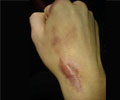A gel that creates a watertight seal to close surgical wounds provides a significant advance in the treatment of patients following spinal procedures, effectively sealing spinal wounds

The gel is an important step forward because even pinhole-sized leaks of spinal fluid can lead to another surgery and can expose the surgical wound to bacteria, increasing the risk of serious infection, including meningitis, said the study's lead author, Kee Kim. Kim is an associate professor of neurological surgery at the School of Medicine at UC Davis, chief of spinal neurosurgery and co-director of the UC Davis Spine Center.
"This substance is synthetic so there is no possibility of disease transmission but does not replace a careful surgical technique of closing the dura with the sutures," Kim said. "This sealant allows easy repair of spinal leak that may be present even after best attempts at dural closure with suturing."
The study, published online in the journal Spine, was conducted in 158 patients treated at 24 centers throughout the United States. It examined the effectiveness and safety of the sealant when used as an adjunct to suturing the dura during surgery.
The gel was approved for use in the spine by the Food and Drug Administration late in 2010.
For the study, patients were randomized in the operating room if a spinal fluid leak was seen after the dura was closed with the sutures. One hundred and two of the patients received the PEG hydrogel spinal sealant and 56 received standard care — closing the dura with additional sutures and/or fibrin glue. Participants were excluded from the study if they had prior spine surgery or were undergoing chemotherapy, radiation treatment or had other compounding health problems, such as compromised immune systems, uncontrolled diabetes or poor renal functioning.
Advertisement
The PEG gel is a liquid that quickly solidifies and forms a tight seal when it comes into contact with the body. Other sealants commonly used to create a watertight seal in spinal wounds include fibrin glue, made from other donor blood or animal matter, which is not optimal because it remains in place for only five to seven days and carries a risk of disease transmission, the researchers said.
Advertisement
Source-Eurekalert










